In Short:
Land of the Lustrous is a 2017 anime by CGI powerhouse Orange about a small group of immortal, genderless people whose entire bodies are made of the gemstone or mineral each is named after. While most of the gems, like Jade or Diamond, are content to carry out their same routines day after day, just as they have for hundreds or even thousands of years, the show’s focus on the spunky but naive and physically brittle Phosphophyllite rewards viewers with one of anime’s best character arcs.
For better or worse, the anime only covers the first few chapters of the manga it is based on. So, while Land of the Lustrous tells an interesting story filled with great characters, some spectacular combat, and a deft combination of fun humor and intense drama, it does end just when it seems the real story is about to begin.
Suggested Minimum Watch: 2 episodes. It would be a big shame to quit the show before you get to meet Dia and Bort.
Full Review:
Land of the Lustrous (houseki no kuni) is one of those rare anime that requires a lot more explanation than usual simply because its setting is so different from anything else out there. It’s not set in a high school, or on a military space ship, or a sports field, or really anywhere else your typical anime is.
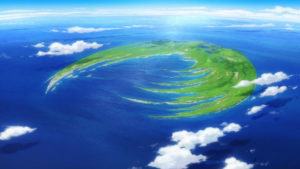 At its simplest, Land of the Lustrous is an anime about a group of immortal sentient humanoid gemstones living together on an otherwise uninhabited grassy island. The gems are primarily organized by their hardness, durability, and personality. The green haired Jade, for instance, is logical and factual and serves the role as the group’s day to day organizer. Bort, with its long black hair and cold, demanding demeanor is the most durable of all the gems and so it serves as their most potent defender. Other gems take on a variety of roles from lookouts to gathers to even a clothing designer and a surgeon of sorts.
At its simplest, Land of the Lustrous is an anime about a group of immortal sentient humanoid gemstones living together on an otherwise uninhabited grassy island. The gems are primarily organized by their hardness, durability, and personality. The green haired Jade, for instance, is logical and factual and serves the role as the group’s day to day organizer. Bort, with its long black hair and cold, demanding demeanor is the most durable of all the gems and so it serves as their most potent defender. Other gems take on a variety of roles from lookouts to gathers to even a clothing designer and a surgeon of sorts.
The gems do not age and cannot really die. They essentially just lose consciousness if sufficiently dismembered, but even if they are shattered by an accident or by an attack, they can always be pieced back together and wake up good as new. They don’t breath, so operating underwater is not much of a hinderance. They don’t eat, per say, since they get their nourishment and energy from the sun, so even food is mostly a non-issue for them. It does mean that they tire easily at night to the point of sometimes falling asleep unintentionally, and that they spend the long cloudy winters in hibernation, but they can, with effort, stay awake, so even those actions are more an inconvenience than an outright limitation. The gems also store their memories all throughout their bodies instead of just in a brain. This means that if they are shattered but not put completely back together they can forget things they once knew. But, since they are immortal, it is rare for them not to be able to track down all the pieces of one of their companions.
 The only true enemy the gems have are the show’s second set of strange, otherworldly creatures: the Lunarians. Their sole goal appears to be to shatter the gems and cart them back off to the moon for some unknown purpose. Each time they appear, they emerge in the sky out of what looks to be strange ink blots that open to reveal a small army riding on a large yellow disc of clouds that hovers above the island. These raiding parties are armed with bows and spears, but they almost seem more ritualistic than warlike, as roughly half the Lunarians in each raid come playing drums, tambourines, or flutes, while others hold flags and banners. If anything, the Lunarians appear to be based in Budist imagery. Interestingly, the Lunarians appear to be made of clouds themselves. They are the same yellow color as the clouds they ride on and they blow away when defeated.
The only true enemy the gems have are the show’s second set of strange, otherworldly creatures: the Lunarians. Their sole goal appears to be to shatter the gems and cart them back off to the moon for some unknown purpose. Each time they appear, they emerge in the sky out of what looks to be strange ink blots that open to reveal a small army riding on a large yellow disc of clouds that hovers above the island. These raiding parties are armed with bows and spears, but they almost seem more ritualistic than warlike, as roughly half the Lunarians in each raid come playing drums, tambourines, or flutes, while others hold flags and banners. If anything, the Lunarians appear to be based in Budist imagery. Interestingly, the Lunarians appear to be made of clouds themselves. They are the same yellow color as the clouds they ride on and they blow away when defeated.
For the most part, the gems are content to live their immortal lives doing the same thing day in and day out for years, decades, centuries, and even millennia at a time. Although there are some, like the doctor Rutile, who show curiosity in their specific fields of expertise, it seems pretty clear that the gems are not especially inquisitive and prefer to simply carry out the roles given to them by their leader, Sensei Kongo.
But then there’s Phos.
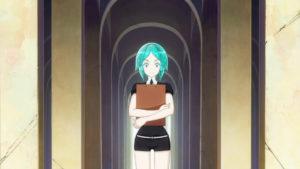 Phos, short for Phosphophyllite, is a brittle, easily cracked peppermint green gem who bears the distinction of being the only one of the gems to not have an assigned task. Phos is upbeat, happy, energetic, and spunky. It is also clumsy, prone to complaining and talking back, and more than a little inattentive. For the first nearly 300 years of its life, Phos has just lounged around in the sun doing little more than occasionally annoying its fellow gems. In all that time, Sensei Kongo has been trying to find a task that the short attention spanned and easily broken Phos can carryout without wandering off or being shattered. Phos seems to be a poor choice for any sort of repetitive task, and even though they wish to take part in what they naively see as the glamour and excitement of combat against the Lunarians, they are far too fragile to do so.
Phos, short for Phosphophyllite, is a brittle, easily cracked peppermint green gem who bears the distinction of being the only one of the gems to not have an assigned task. Phos is upbeat, happy, energetic, and spunky. It is also clumsy, prone to complaining and talking back, and more than a little inattentive. For the first nearly 300 years of its life, Phos has just lounged around in the sun doing little more than occasionally annoying its fellow gems. In all that time, Sensei Kongo has been trying to find a task that the short attention spanned and easily broken Phos can carryout without wandering off or being shattered. Phos seems to be a poor choice for any sort of repetitive task, and even though they wish to take part in what they naively see as the glamour and excitement of combat against the Lunarians, they are far too fragile to do so.
Phos is the lead character of the show, and deservedly so. Early on, it is tasked by Sensei Kongo to compile an encyclopedia for the other gems. It immediately tries to find a way out of the job either by getting others to fill in for it, or by at least roping one of the other gems in as an assistant. In the early episodes, Phos’ wit and spunk shine, filling each scene with humor and laughs. Land of the Lustrous could have easily padded out its twelve episodes with Phos’ delightfully dismissive antics, but it goes far above and beyond that. Where this could have been a show of nothing but humor, Land of the Lustrous is actually more an examination of tragedy and change, with most of that change happening to Phos itself. One of the strongest points of the show is the arc Phos goes through. The Phos we see by the end of the twelfth episode is a far different character than the Phos we get in episode one.
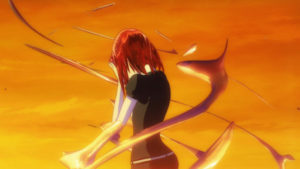 Phos’ journey is set in motion by Cinnabar, a second oddity among the gems. Where most of the gems, including Phos, live together on the island, Cinnabar lives alone away from the others by its own choice. Cinnabar, you see, is literally toxic to the plants and animals of the island thanks to the never ending flow of mercury it exudes. This mercury is even dangerous to the other gems as it can damage their finish and prevent them from absorbing the sun’s rays. Early on, Phos hears that Cinnabar is very clever, so it tries to rope Cinnabar into its encyclopedia task only to learn Cinnabar has a tragic secret.
Phos’ journey is set in motion by Cinnabar, a second oddity among the gems. Where most of the gems, including Phos, live together on the island, Cinnabar lives alone away from the others by its own choice. Cinnabar, you see, is literally toxic to the plants and animals of the island thanks to the never ending flow of mercury it exudes. This mercury is even dangerous to the other gems as it can damage their finish and prevent them from absorbing the sun’s rays. Early on, Phos hears that Cinnabar is very clever, so it tries to rope Cinnabar into its encyclopedia task only to learn Cinnabar has a tragic secret.
Although Cinnabar is tasked with performing the night watch for the other gems thanks to the way its mercury lets it live off starlight, this tasks is actually pointless and futile. The Lunarians have never once, in several thousands years, appeared after sundown. When Phos finally meets Cinnabar, the latter admits it would welcome being incapacitated and taken away to the moon if only to end its monotony and isolation. Day after day and night after night Cinnabar stands waiting for the Lunarians to come for it, yet, for some reason, they never do. That it isn’t even desired by the Lunarians only serves to push Cinnabar into further self-loathing.
 When Phos learns of this shocking, bitter secret, it makes a hasty yet sincere promise to Cinnabar to find them a better job than the night watch. To find Cinnabar a job that only it can do. This heartfelt promise from the flighty Phos, who has likely never promised anyone anything like this before, drives much of the plot throughout the rest of the show.
When Phos learns of this shocking, bitter secret, it makes a hasty yet sincere promise to Cinnabar to find them a better job than the night watch. To find Cinnabar a job that only it can do. This heartfelt promise from the flighty Phos, who has likely never promised anyone anything like this before, drives much of the plot throughout the rest of the show.
Graphics & Sound
One of the first things you often hear about Land of the Lustrous is how it is computer animated. This is a rather divisive issue among anime fans as 3d computer animated shows are often thought to be more clunky and less fluid and expressive than 2d hand drawn shows. Land of the Lustrous got around these problems by taking the best of both worlds. Orange brought in noted 2d animators to help with storyboarding and combat scenes. They would sometimes literally draw expressive line art on top of the unfinished computer animations to give the computer animators tips and goals to shoot for, ensuring that the show remained just as expressive as the best hand drawn anime.
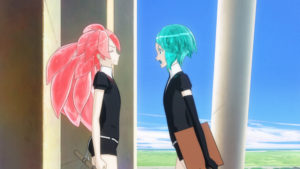 Orange also recorded the voice actors first and did the animations second. This is opposite of the way most 2d and 3d anime are done. By recording the voices first, it gives the animators something to work off of. They were able to time movements and invent new animations that added fluidity in time with each characters’ already recorded voices. The end results is that Land of the Lustrous has an extra level of snappiness and expression that you don’t often get in anime.
Orange also recorded the voice actors first and did the animations second. This is opposite of the way most 2d and 3d anime are done. By recording the voices first, it gives the animators something to work off of. They were able to time movements and invent new animations that added fluidity in time with each characters’ already recorded voices. The end results is that Land of the Lustrous has an extra level of snappiness and expression that you don’t often get in anime.
But beyond all that, the show is just beautiful! Land of the Lustrous makes brilliant use of lighting and color. The island the gems live on is detailed and scenic from its wave-swept beaches to its marshy forests to the two white stone structures the gems live in. It had me captivated by the very first blade of green grass that came on the screen.
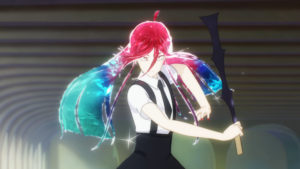 Each gem looks spectacular, as well, with their own diverse styles and colors of translucent hair that casts light on nearby objects and environments. One of my favorite visual tricks the show pulls is showing that the irises of each gem are, in fact, composed of a complex facet of gemstone shapes that appear whenever the camera gets close enough. The Lunarians, too, have such an interesting and creepy look to them that feels so different from everything else in the show. They have an entirely different visual style that can at times be awe inspiring.
Each gem looks spectacular, as well, with their own diverse styles and colors of translucent hair that casts light on nearby objects and environments. One of my favorite visual tricks the show pulls is showing that the irises of each gem are, in fact, composed of a complex facet of gemstone shapes that appear whenever the camera gets close enough. The Lunarians, too, have such an interesting and creepy look to them that feels so different from everything else in the show. They have an entirely different visual style that can at times be awe inspiring.
A lot of the show’s general look and feel comes from its manga. While the Land of the Lustrous anime is not a shot for shot recreation, it does take some of the best panels from the manga and mixes them up where necessary to make a more compelling tv show. This is a fine line to walk, as showing the same scene from a different angle could ruin it, but Orange pulled it off with room to spare. Check the Dig Deeper section below for some links to videos that go in-depth about the show’s visuals.
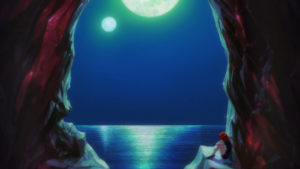 On the audible front, I love this show’s sounds and music just as much as I love its colors and animation. There’s this great mix of piano and strings and horns and more exotic instruments that come together to create a wide variety of moods. Special call out goes to the chillingly strong piano notes of the main theme you get just seconds into starting the first episode.
On the audible front, I love this show’s sounds and music just as much as I love its colors and animation. There’s this great mix of piano and strings and horns and more exotic instruments that come together to create a wide variety of moods. Special call out goes to the chillingly strong piano notes of the main theme you get just seconds into starting the first episode.
I actually bought the soundtrack to this one like I do for all the anime whose music I love, and it’s been great to listen to Phosphophyllite’s upbeat, hopeful theme as well as the sad, worrisome, lonely theme provided to Cinnabar. Then, of course, there’s Sunspot, the strange theme filled with bells and tambourines that plays whenever the Lunarians appear. The battle theme, Battle, is great too!
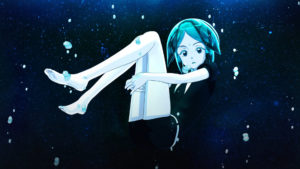 I also love the show’s opening. It has a complexity about both its graphics and audio that is entrancing. It’s also interesting because while Phos is the one who dominates the screen, the song itself appears to be sung by Cinnabar. Listen closely to the lyrics where the singer talks about being the only one to wander through the night. Those words don’t belong to Phos or any of the other gems!
I also love the show’s opening. It has a complexity about both its graphics and audio that is entrancing. It’s also interesting because while Phos is the one who dominates the screen, the song itself appears to be sung by Cinnabar. Listen closely to the lyrics where the singer talks about being the only one to wander through the night. Those words don’t belong to Phos or any of the other gems!
Finally, in regards to voice acting, Land of the Lustrous is excellent there as well. The Japanese cast did an amazing job bringing their respective characters to life. Phos’ voice actress, in particular, brings a ton of energy and fun to the character. The show’s English dub is also very good. The Japanese cast set a hard act to follow, but the English actors did a great job. I was a little afraid for the English dub just because of how fast paced and nuanced characters like Phos could be at times, but the English actors for Phos and the other gems matched those performances to my satisfaction.
All In All:
Land of the Lustrous is an interesting show that is unique even among other great anime. Its setting and concepts are delightfully alien while still being relatable. Its look, animation, and sound are excellent. And, its characters’ desires and motivations, especially those of its lead character Phos and secondary character Cinnabar, are complex in ways you may not expect from just watching the first episode.
Even though it tells an enjoyable story on a surface level, Land of the Lustrous is, in some ways, one of the most complex anime I’ve ever recommended. Its characters and their motivations are often pulled in opposite directions. The show itself has overarching and deeply rooted Buddhist themes. And, the show is bold enough to often have its characters greatest learning moments be their biggest failures. I may be a little scattered here, because there is so much to talk about, but let me share a few things that I think push Land of the Lustrous above and beyond.
One of my favorite parts of Land of the Lustrous is just how much Phos changes throughout the course of the show. The final episode has a great moment where Phos looks back at its past self, but there are some great moments along the way that made me love Phos all the more.
After Phos gets its new legs and its super speed, it joins the Amethyst twins and quickly finds out that joining the other gems out on patrol is not nearly as cools as it had hoped. It was great to see Phos spend the entire first day jumping at every little thing that happened. A few days later, we see that Phos has already grown tired of waiting. It was a neat demonstration on how sometimes the fantasy of a thing doesn’t match the reality.
Another great moment is when Phos is chasing down the Lunarians that are stealing away Antarcticite. Phos’ lines about overcoming its limits but still failing were unexpectedly powerful to me. In most other shows, Phos would have succeeded, having finally come to grips with the responsibility it owed its fellow gems, but that wasn’t the point here. I loved the way Land of the Lustrous used hope followed by further failure to grow Phos’ character.
Cinnabar also got some neat subtle moments. Throughout the series, Cinnabar all but refuses to interact with the other gems. Even when it could have stepped out of the shadows and alerted all the gems looking for Phos under the sea, it didn’t. Why not? It all comes back to Cinnabar’s true motivations for staying away.
Yes, Cinnabar was tired of being alone and terribly distraught at the way its poisonous mercury harmed and killed everything around it, but that wasn’t the real reason Cinnabar stayed away. Instead, listen again to what Cinnabar says in the first episode when it is complaining to itself about wanting to be free of the night. It also says that no, it can’t trust Phos.
For the longest time I forgot about that part. It seemed out of place and unimportant, until it was made clear that Cinnabar didn’t trust Sensei Kongo and the other gems precisely for the same reasons as Phos is losing trust at the end of the series. Cinnabar had long ago determined that there was some link between Kongo and the Lunarians, but unlike the other gems who were mostly content to continue on with their lives, Cinnabar distanced itself from Kongo and thus the gems that he led. I love how this second layer gives Cinnabar’s actions so much more meaning once you realize what is going on.
Finally, there’s something I didn’t want to talk about in the main review. It’s that I’m actually happy that Land of the Lustrous has not gotten a second season. I kinda don’t want it to ever get another season even though it does end itself on a major cliffhanger. This is because I don’t like the direction the manga heads in. What I wanted to happen is for Cinnabar and Phos to join forces and solve the mystery of the Lunarians together. Things didn’t need to end perfectly happy, but I was happy with where Phos and Cinnabar ended up by the end of the season. I wanted to follow those characters through to their eventual conclusion.
That doesn’t happen.
Instead, the manga sees Phos get more and more pieces replaced, most notably its head. Phos actually gets taken to the moon where it communicates and joins forces with the Lunarians. Phos eventually sparks a kind of civil war between the gems back on earth. There’s also the revelation that the Lunarians were grinding the captured gems into dust and spreading them out on the surface of the moon because they wanted Kongo to see and agree to their demands. I would be fine with that except the manga then breaks the rule about the gems always being able to be put back together. It is said that any of the weaker gems spread out this way had their inclusions bleached away and were truly dead. This included Antarcticite, which made me very unhappy.
In general the manga sounds like it just gets more and more unhappy, to the point that an even more drastically changed Phos at one point demands that Sensei Kongo murder it because it cannot live with itself and what it has done. I will check back once the manga finishes. A good ending could very well be worth all the turmoil to get there. But for now, I don’t want to read most of what I’ve heard about and consequently, I don’t want to see it animated either.
As usual, I do have a few recommendations if you want to learn more about this anime:
- Land of the Lustrous: A PERFECT Adaptation This video goes in depth for a shot for shot, panel for panel look at how the anime followed and expanded on its manga’s lead to create a fantastically artistic visuals.
- What Makes a Soundtrack Great – Land of the Lustrous & What Makes Cinnabar’s Theme So Emotional (Let’s Talk About The Erhu) takes a look at the show’s music in general, and Cinnabar’s theme in particular.
- The most complex pop anime OP looks at the crazy musical timing of Land of the Lustrous’ opening song.
- Finally, if you really love the show like I do, I highly recommend Nearly On Red’s fantastic 10+ hour Episode by Episode Breakdown that goes all in on examining the show’s plot and characters. Note, that an episode 12 breakdown exist as a twitch livestream viewing of the twelfth episode and more than an hour of comments afterwards.